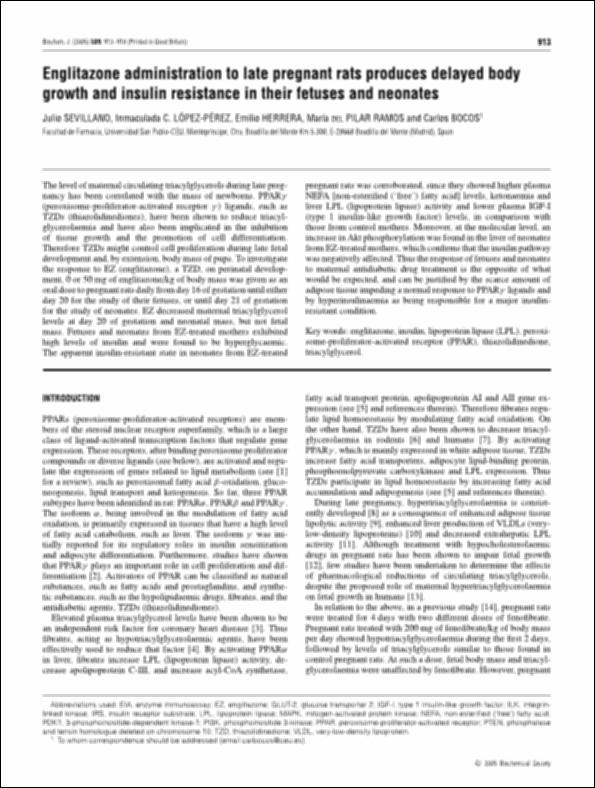Por favor, use este identificador para citar o enlazar este ítem:
http://hdl.handle.net/10637/582Englitazone administration to late pregnant rats produces delayed body growth and insulin resistence in their fetuses and neonates.
| Título : | Englitazone administration to late pregnant rats produces delayed body growth and insulin resistence in their fetuses and neonates. |
| Autor : | Sevillano Fernández, Julio López-Pérez, Inmaculada C. Herrera Castillón, Emilio. Ramos Álvarez, María del Pilar Bocos de Prada, Carlos |
| Materias: | Englitazone.; Insulin.; Lipoprotein lipase (LPL).; peroxisome-proliferator-activated receptor (PPAR).; Thiazolidinedione.; Triacylglycerol. |
| Resumen : | The level of maternal circulating triacylglycerols during late pregnancy has been correlated with the mass of newborns. PPARγ (peroxisome-proliferator-activated receptor γ ) ligands, such as TZDs (thiazolidinediones), have been shown to reduce triacylglycerolaemia and have also been implicated in the inhibition of tissue growth and the promotion of cell differentiation. Therefore TZDs might control cell proliferation during late fetal development and, by extension, body mass of pups. To investigate the response to EZ (englitazone), a TZD, on perinatal development, 0 or 50 mg of englitazone/kg of body mass was given as an oral dose to pregnant rats daily from day 16 of gestation until either day 20 for the study of their fetuses, or until day 21 of gestation for the study of neonates. EZ decreased maternal triacylglycerol levels at day 20 of gestation and neonatal mass, but not fetal mass. Fetuses and neonates from EZ-treated mothers exhibited high levels of insulin and were found to be hyperglycaemic. The apparent insulin-resistant state in neonates from EZ-treated pregnant rats was corroborated, since they showed higher plasma NEFA [non-esterified (‘free’) fatty acid] levels, ketonaemia and liver LPL (lipoprotein lipase) activity and lower plasma IGF-I (type 1 insulin-like growth factor) levels, in comparison with those from control mothers. Moreover, at the molecular level, an increase in Akt phosphorylation was found in the liver of neonates from EZ-treated mothers, which confirms that the insulin pathway was negatively affected. Thus the response of fetuses and neonates to maternal antidiabetic drug treatment is the opposite of what would be expected, and can be justified by the scarce amount of adipose tissue impeding a normal response to PPARγ ligands and by hyperinsulinaemia as being responsible for a major insulinresistant condition. |
| Descripción : | En: Biochemical journal, ISSN 0264-6021 2005. Vol. 389 (Pt 3) pp. 913-918 |
| URI : | http://hdl.handle.net/10637/582 |
| Derechos: | http://creativecommons.org/licenses/by-nc-nd/4.0/deed.es |
| Fecha de publicación : | 19-sep-2005 |
| Centro : | Universidad San Pablo-CEU |
| Aparece en las colecciones: | Facultad de Farmacia |
Los ítems de DSpace están protegidos por copyright, con todos los derechos reservados, a menos que se indique lo contrario.


